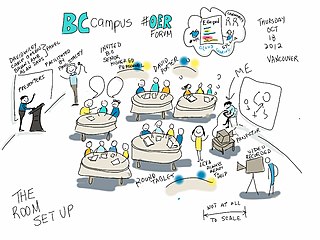The term large-group awareness training (LGAT) refers to activities—usually offered by groups with links to the human potential movement—which claim to increase self-awareness and to bring about desirable transformations in individuals' personal lives. LGATs are unconventional; they often take place over several days, and may compromise participants' mental wellbeing.

Consensus decision-making or consensus process is a group decision-making process in which participants develop and decide on proposals with the goal of achieving broad acceptance, defined by its terms as form of consensus. The focus on establishing agreement of at least the majority or the supermajority and avoiding unproductive opinion differentiates consensus from unanimity, which requires all participants to support a decision. Consensus decision-making in a democracy is consensus democracy.
A meeting is when two or more people come together to discuss one or more topics, often in a formal or business setting, but meetings also occur in a variety of other environments. Meetings can be used as form of group decision-making.

Community service is work performed by a person or group of people for the benefit and betterment of their community contributing to a noble cause. In many cases, people doing community service are compensated in other ways, such as those helping getting a lunch for free. In many countries, there are programs to incite people to do community service. People may do community service to get citizenship. In some cases, it is possible to replace a criminal justice sanctions with community service. There may also be school or class requirements. Obtaining certain benefits may be linked to doing some form of community service. For all these reasons, it is distinct from volunteering.
An electronic meeting system (EMS) is a type of computer software that facilitates creative problem solving and decision-making of groups within or across organizations. The term was coined by Alan R. Dennis et al. in 1988. The term is synonymous with group support systems (GSS) and essentially synonymous with group decision support systems (GDSS). Electronic meeting systems form a class of applications for computer supported cooperative work.
Organizational storytelling is a concept in management and organization studies. It recognises the special place of narration in human communication, making narration "the foundation of discursive thought and the possibility of acting in common." This follows the narrative paradigm, a view of human communication based on the conception of persons as homo narrans.
Formal consensus refers to a specific organizational structure which formalizes both the relationships between members of an organization and the processes through which they interact to create an environment in which consensus decision-making can occur in a specific, consistent, and efficient manner. While many diverse consensus decision-making techniques exist, formal consensus emphasizes the concept that the particular process by which a decision is made is equally significant to gaining consensus as the content of any proposal or discussion.
The law of triviality is C. Northcote Parkinson's 1957 argument that people within an organization commonly give disproportionate weight to trivial issues. Parkinson provides the example of a fictional committee whose job was to approve the plans for a nuclear power plant spending the majority of its time on discussions about relatively minor but easy-to-grasp issues, such as what materials to use for the staff bicycle shed, while neglecting the proposed design of the plant itself, which is far more important and a far more difficult and complex task.

Parker J. Palmer is an American author, educator, and activist who focuses on issues in education, community, leadership, spirituality and social change. He has published ten books and numerous essays and poems, and is founder and Senior Partner Emeritus of the Center for Courage and Renewal. His work has been recognized with major foundation grants, several national awards, and thirteen honorary doctorates.
Joint application design is a term originally used to describe a software development process pioneered and deployed during the mid-1970s by the New York Telephone Company's Systems Development Center under the direction of Dan Gielan. Following a series of implementations of this methodology, Gielan lectured extensively in various forums on the methodology and its practices. Arnie Lind, then a Senior Systems Engineer at IBM Canada in Regina, Saskatchewan created and named joint application design in 1974. Existing methods, however, entailed application developers spending months learning the specifics of a particular department or job function, and then developing an application for the function or department. In addition to development backlog delays, this process resulted in applications taking years to develop, and often not being fully accepted by the application users.

A facilitator is a person who helps a group of people to work together better, understand their common objectives, and plan how to achieve these objectives, during meetings or discussions. In doing so, the facilitator remains "neutral", meaning they do not take a particular position in the discussion. Some facilitator tools will try to assist the group in achieving a consensus on any disagreements that preexist or emerge in the meeting so that it has a solid basis for future action.

"Crazy" Therapies: What Are They? Do They Work? is a book by the psychologist Margaret Singer and the sociologist Janja Lalich. It was published by Jossey-Bass in 1996.
Edwin C. Nevis was an American gestalt therapist who identified Maslow's hierarchy of needs as culturally relative and formulated a hierarchy of needs for Chinese culture and a mode of classifying hierarchies of needs in different cultures. He co-founded the Gestalt Institute of Cleveland and founded the Gestalt International Study Center, and was a faculty member in management at the MIT Sloan School of Management.
The nominal group technique (NGT) is a group process involving problem identification, solution generation, and decision-making. It can be used in groups of many sizes, who want to make their decision quickly, as by a vote, but want everyone's opinions taken into account. The method of tallying is difference. First, every member of the group gives their view of the solution, with a short explanation. Then, duplicate solutions are eliminated from the list of all solutions, and the members proceed to rank the solutions, 1st, 2nd, 3rd, 4th, and so on.

Graphic facilitation is the use of a combination of graphics such as diagrams, pictures, symbols, and writing to lead people toward a goal in meetings, seminars, workshops and conferences. The graphics are usually drawn by hand, by a person called a graphic facilitator, who may create the graphics in real time during the event and may work alone or together with another person called a facilitator who aids the discussion.
An account manager (AM) is a person who works for a company and is responsible for the management of sales and relationships with particular customers. An account manager maintains the company's existing relationships with a client or group of clients, so that they will continue using the company for business. Account managers do not manage the daily running of the account. They manage the relationship with the client of the account(s) they are assigned to. Generally, a client will remain with one account manager throughout the account's duration. Account managers serve as the interface between the customer service and the sales no in a company. They are assigned a company's existing client accounts. The purpose of being assigned particular clients is to create long term client relationships. The account manager serves to understand the customer's demands, plan how to meet these demands, and generate sales for the company as a result.
Herbert Allen Shepard (1919–1985) was a Canadian-born American organization behaviorist and economist who made a significant contribution to Organization Development He held faculty posts at several universities including M.I.T., where he received his doctorate in Industrial Economics. He founded and directed the first doctoral program in Organization Development at Case Western Reserve; developed a residency in administrative psychiatry at Yale University School of Medicine, and was also President of The Gestalt Institute of Cleveland and The Professional Development Institute.
Chickering's Theory of Identity Development, as articulated by Arthur W. Chickering explains the process of identity development. The theory was created specifically to examine the identity development process of students in higher education, but it has been used in other areas as well.
Intergroup dialogue is a "face-to-face facilitated conversation between members of two or more social identity groups that strives to create new levels of understanding, relating, and action". This process promotes conversation around controversial issues, specifically, in order to generate new "collective visions" that uphold the dignity of all people. Intergroup dialogue is based in the philosophies of the democratic and popular education movements. It is commonly used on college campuses, but may assume different namesakes in other settings.
Cultural agility is a term employed in talent management to design a complex competency based on skills whose command allows an individual or an organization to perform successfully in cross-cultural situations. Cultural agility has been conceptualized as an individual's ability to comfortably and effectively work in different cultures and with people from different cultures, national origins, generations, gender, etc. People with cultural agility are able to "build trust, gain credibility, communicate, and collaborate effectively across cultures". The concept appears to overlap with others such as cross-cultural competence and cultural intelligence. The subject has been linked to studying abroad, foreign talent acquisition, immigrants and refugees, career success, sports coaching, leadership development, and global business. Currently, the term is often associated with research carried out by Paula Caligiuri, and a few others like Marisa Cleveland, and Zeinab Shawky Younis. On psychological aspects, the command of cultural agility resources may be facilitated by personality traits like extraversion, openness, and predisposition to novelty seeking, but also by appropriate learning. Self-assessment has been pointed out as a practical approach to evaluate the level of competence reached by cultural agility trainees.





